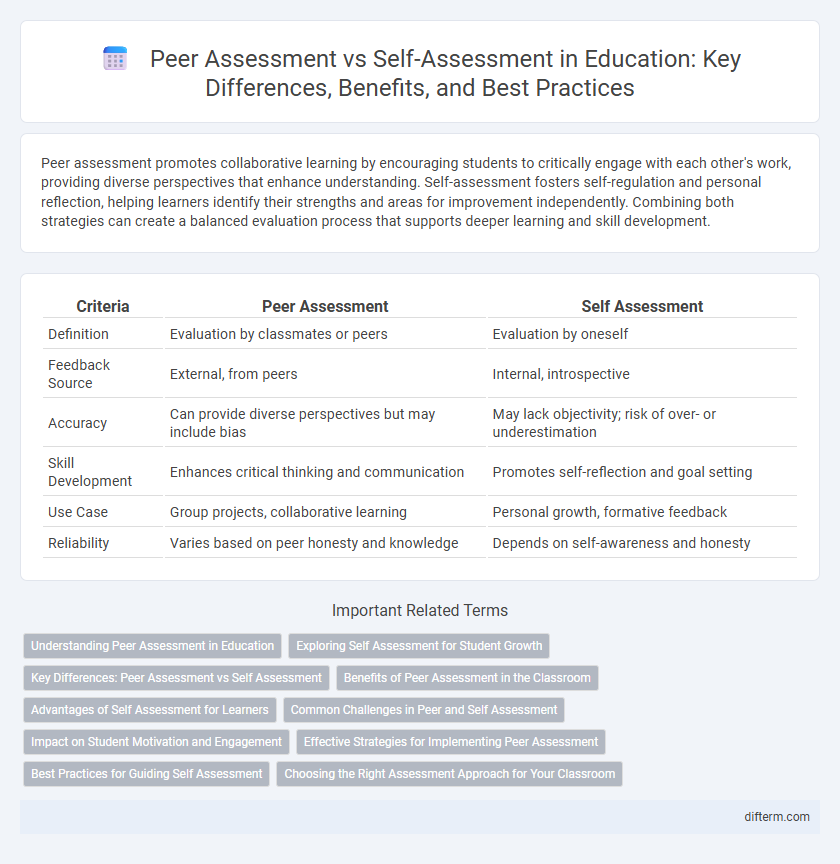Peer assessment promotes collaborative learning by encouraging students to critically engage with each other's work, providing diverse perspectives that enhance understanding. Self-assessment fosters self-regulation and personal reflection, helping learners identify their strengths and areas for improvement independently. Combining both strategies can create a balanced evaluation process that supports deeper learning and skill development.
Table of Comparison
| Criteria | Peer Assessment | Self Assessment |
|---|---|---|
| Definition | Evaluation by classmates or peers | Evaluation by oneself |
| Feedback Source | External, from peers | Internal, introspective |
| Accuracy | Can provide diverse perspectives but may include bias | May lack objectivity; risk of over- or underestimation |
| Skill Development | Enhances critical thinking and communication | Promotes self-reflection and goal setting |
| Use Case | Group projects, collaborative learning | Personal growth, formative feedback |
| Reliability | Varies based on peer honesty and knowledge | Depends on self-awareness and honesty |
Understanding Peer Assessment in Education
Peer assessment in education enhances deeper learning by encouraging students to critically evaluate their classmates' work, promoting active engagement and collaborative skills. It fosters a diverse range of perspectives, helping learners identify strengths and weaknesses through constructive feedback. This method improves metacognitive abilities and accountability, complementing self-assessment by providing external insights that students alone might overlook.
Exploring Self Assessment for Student Growth
Self-assessment empowers students to develop critical reflection skills by evaluating their own learning progress and identifying areas for improvement. This practice enhances metacognitive abilities, fostering deeper understanding and promoting autonomous learning. Research indicates that incorporating structured self-assessment strategies can lead to improved academic performance and increased student motivation.
Key Differences: Peer Assessment vs Self Assessment
Peer assessment involves students evaluating each other's work, promoting collaborative learning and providing diverse feedback, while self-assessment requires individuals to critically reflect on their own performance, enhancing metacognitive skills and personal accountability. Peer assessment often encourages social interaction and perspective-taking, whereas self-assessment fosters independent learning and self-regulation. The key difference lies in the source of evaluation: external input from peers versus introspective judgment by oneself.
Benefits of Peer Assessment in the Classroom
Peer assessment in the classroom enhances critical thinking and communication skills by allowing students to evaluate and provide constructive feedback on each other's work. It fosters collaborative learning environments where diverse perspectives help deepen understanding and promote accountability. Research shows peer assessment improves retention and motivation by engaging learners actively in the evaluation process.
Advantages of Self Assessment for Learners
Self-assessment empowers learners by promoting critical thinking and self-reflection, leading to deeper understanding and improved retention of knowledge. It fosters autonomy and responsibility, enabling students to identify strengths and areas for improvement without external judgment. The process enhances motivation and engagement, as learners actively participate in setting goals and monitoring their own progress.
Common Challenges in Peer and Self Assessment
Common challenges in peer and self assessment include bias, lack of objectivity, and limited evaluation skills among students. Students may struggle with providing constructive feedback or accurately judging their own or peers' work quality, leading to inconsistent grading. These difficulties often result in reduced reliability and validity of the assessment outcomes in educational settings.
Impact on Student Motivation and Engagement
Peer assessment fosters collaborative learning environments that enhance student motivation by promoting accountability and social interaction, which increases engagement through active participation and feedback exchange. Self-assessment empowers students to develop metacognitive skills, leading to greater intrinsic motivation and a deeper commitment to their learning goals. Both methods contribute uniquely to motivation and engagement, with peer assessment emphasizing external feedback and self-assessment reinforcing internal reflection and personal growth.
Effective Strategies for Implementing Peer Assessment
Effective strategies for implementing peer assessment include clear rubrics, structured training sessions, and anonymous feedback systems to ensure objectivity and constructive criticism. Integrating technology platforms that facilitate real-time feedback enhances engagement and accuracy in peer evaluations. Encouraging reflective practices alongside peer assessment promotes deeper learning and critical thinking skills among students.
Best Practices for Guiding Self Assessment
Effective self-assessment practices emphasize clear criteria and reflective prompts that help learners critically evaluate their own work against established standards. Incorporating regular feedback loops and training students on metacognitive strategies enhances accuracy and promotes deeper learning engagement. Utilizing digital tools can further support self-assessment by providing immediate insights and tracking progress over time.
Choosing the Right Assessment Approach for Your Classroom
Selecting the appropriate assessment method depends on learning objectives and student needs. Peer assessment promotes critical thinking and collaborative skills by encouraging students to evaluate each other's work, while self-assessment fosters metacognitive abilities and personal accountability by having students reflect on their own progress. Combining both approaches strategically can enhance engagement and provide comprehensive insights into student learning outcomes.
peer assessment vs self assessment Infographic

 difterm.com
difterm.com